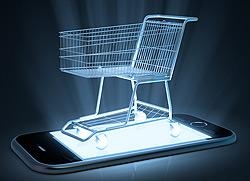 Consumer packaged goods companies are underestimating the e-commerce channel’s growth potential, lack clear e-commerce strategies, and risk
missing out on a substantial market opportunity, according to a new Deloitte study.
Consumer packaged goods companies are underestimating the e-commerce channel’s growth potential, lack clear e-commerce strategies, and risk
missing out on a substantial market opportunity, according to a new Deloitte study.
For this first part of a two-part “Digital Commerce
in the Supermarket Aisle" study, Deloitte recently surveyed 43 CPG industry executives (60% in food companies, the rest in beverages, household goods or personal care products companies). Most
respondents spend at least 20% of their time on digital commerce activities, and 51% are from large companies (annual sales $10 billion or more). In-depth interviews were conducted with selected
executives.
advertisement
advertisement
Deloitte separately surveyed 2,010 adults (ages 21-70) who are the primary shoppers and food preparers in their households,
and who had purchased a product online in the past six months. (Sixty-six percent of respondents were females; 42% of total respondents had household incomes under $50,000, 36% between $50,000 and
$99,999, and 21% $100,000 or more.)
One core finding: Consumers’ intent to purchase CPG products online far exceeds CPG
executives’ expectations for growth.
On average, CPG executives expect 35% online sales growth in the next year and 76% growth in three
years. In contrast, consumers expect their online CPG purchases to increase by 67% in the next year and by 158% in three years.
The
research also identified a major digital growth opportunity in “indifferent” consumers – meaning the 41% of consumers who said that they neither like nor dislike shopping at
supermarkets for CPG products.
These “indifferent” shoppers, combined with those who actively dislike shopping at
supermarkets, are most likely to consider e-commerce for CPG products, conclude the researchers. They point out that, given the right incentives, these consumers could be enticed to shop online for
their products.
Importantly, the results suggest that many companies may be behind in their readiness to leverage these opportunities to
optimize online sales. Only 43% of the CPG executives think that their companies have a clear, well-understood digital commerce strategy.
“Increasingly, consumers desire the convenience of the online channel to purchase their groceries,” sums up Pat Conroy, vice chairman, Deloitte LLP and consumer products sector
leader. “Although consumers are changing their behavior, CPG companies are not as prepared as the data suggests they should be to take full advantage of this growing opportunity. The importance
of e-commerce to CPG companies has not, in most cases, translated into a fully-developed strategy for capitalizing on this channel.”
Other key findings:
*On average, CPG executives said they believe that just 2% the past year’s e-commerce revenue came from
completely new sales. But consumers reported that 10% of their online food and personal goods purchases over the past year have been completely new (purchases they would not have made at all had the
online purchasing option not been available).
Conclusion: CPG companies with strong e-commerce strategies/capabilities should have
potential to take market share from competitors, and perhaps to increase consumption.
*While most executives correctly estimate that
most consumers dislike grocery shopping due to the time it consumes, fewer credit additional factors that many consumers dislike about in-store shopping. These include inconvenience (47%), the crowds
in stores (42%) and traveling to and from the retail store (39%).
*For consumers, the potential downsides to purchasing CPG products
online include being unable to touch and view products online and paying shipping charges. However, the research identified several e-commerce drivers that are becoming more prevalent or available,
including: free at-home delivery (84% of consumers consider this important or very important); pricing similar to or less than traditional physical stores (80%); and free in-store pick-up (67%). Some
consumers also note that larger product selections are often available online.
*The research confirmed that CPG executives see e-commerce as
presenting "transformative" opportunities across the entire path to purchase, reports Deloitte.
Specifically, 90% say digital commerce will
improve brand awareness; 86% say it will drive product trial/initial purchases; 93% say it will drive repeat purchases; and 88% say it will facilitate reconnecting with lapsed
customers.
Further, they expect e-commerce's importance to be amplified by rapid change in complementary technology. Most CPG executives
plan to increase investment in in-store shopper engagement (74%), social referral (70%), mobile consumer engagement (68%), mobile market research (67%) and mobile e-commerce
(67%).
Capitalizing on e-Commerce Opportunities
To fully
capitalize on the e-commerce channel, CPG executives first need to establish a clear digital commerce strategy, says Conroy.
In
addition, he says, they should collaborate with retailers and social media platforms, and build a single view of the consumer – while also building and fostering internal talent bases that
include digital commerce skill sets.
"e-Commerce" photo from Shutterstock.